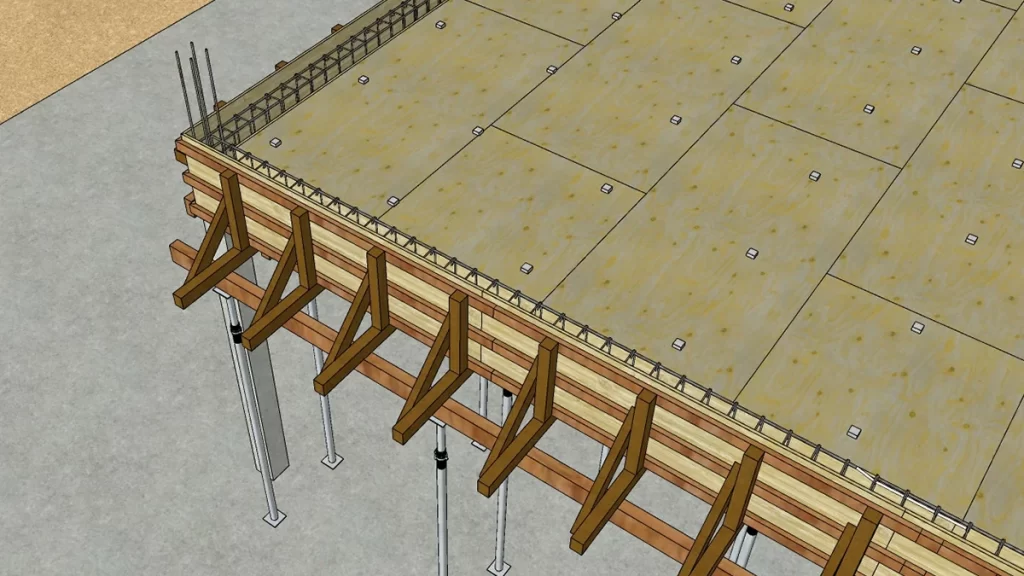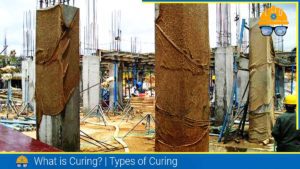Removal of formwork is also known as stripping or strike-off formwork. This should be done only after the concrete has gained a sufficient amount of strength. When stripping formwork, the concrete is subjected to double the stress before the removal of formwork.
What is Stripping of Formwork?
After completion of casting any concrete work, the removal of formwork shall not be immediate or shall be intimate to the site engineer for advice and approval to remove the formwork. Formwork shall be strike-off after the advice and approval received from the site engineer. Formwork removal shall not cause any damage or damages to the newly laid concrete due to racking and vibration or due to poor handling and carelessness of the worker.
For the slab and beam, the side formwork of the beam shall be stripped out first and then the underside propping and formwork to be removed from the slab. Lastly, the underside of the beam is to be removed safely. Removing in series will minimize or will have no damage caused to the structure and no injuries to the works.

Also, read: What is Formwork?
Points to Be Remembered.
- Follow the engineer’s or contractor’s instructions: The engineer or contractor will provide specific instructions for when and how to remove the formwork. Follow these instructions carefully to avoid damaging the concrete or putting workers at risk.
- Inspect the formwork: Before removing the formwork, inspect it for any signs of damage or wear. If there are any damaged sections, they should be repaired or replaced before the formwork is removed.
- Check the concrete strength: Make sure the concrete has reached sufficient strength before removing the formwork. This will help prevent damage to the concrete and ensure that the structure is structurally sound.
- Use proper equipment: Use the appropriate tools and equipment to remove the formwork safely and efficiently. This may include power tools, hand tools, and lifting equipment.
- Avoid damaging the concrete: Take care not to damage the concrete while removing the formwork. This may involve using pry bars or other tools to carefully loosen the formwork without damaging the concrete surface.
- Protect workers: Make sure that workers involved in formwork removal wear appropriate personal protective equipment, such as gloves, safety glasses, and hard hats. Workers should also be trained in proper lifting techniques and should use proper tools and equipment to prevent injury.
- Reuse or recycle the formwork: If possible, consider reusing or recycling the formwork to reduce waste and save money. Proper handling and maintenance of the formwork can extend its lifespan and allow it to be used for multiple projects.
Also, read: Shuttering/Formwork for Structure Members for Building Construction
Factor Affecting Removal of Formwork.
The following factors can affect the removal of formwork:
Strength of the concrete: The strength of the concrete is the primary factor that determines when the formwork can be removed. If the concrete has not reached sufficient strength, removing the formwork too soon can cause damage to the concrete
Grade of Cement: Ordinary Portland cement of grades 33, 43 and 53 have different setting times. Cement with a higher grade offers a quick setting and it gains strength in a shorter time.
Type of Cement: The cement type used in concrete also affects the strength development of concrete. As rapid hardening cement sets quicker than other types of cement, thus there is faster development of strength.
Weather conditions: Extreme weather conditions, such as high temperatures or excessive humidity, can affect the rate at which concrete sets and hardens. This can impact the timing of formwork removal.
Design of the structure: The complexity and design of the structure can also affect the removal of the formwork. For example, if the structure has a lot of curves or intricate details, it can be more challenging to remove the formwork without damaging the concrete.
Size of the concrete members: Larger sectional size concrete members take a longer time to completely set and gain the strength that of mass concrete works. Whereas smaller sectional concrete members can set quickly and removal of formwork is faster compared to larger section members.
Also, read: What is Mass Concrete?
Time of Removing Formwork
| Sl.No. | Types of Formwork | Minimum period before striking off |
|---|---|---|
| 1 | Column, Post, Pillar, RC. Wall | 16-24 hrs. |
| 2 | Slab Soffit formwork | 3days |
| 3 | Beam Soffit formwork | 7days |
| 4 | Props to slabs spanning up to 4.5 m | 7days |
| 5 | Props to slabs spanning over 4.5 m | 14days |
| 6 | Props to beams and arches spanning up to 6m | 14days |
| 7 | Props to beams and arches spanning over 6m | 21days |
Also, read: What are Concrete Column Kickers? | Column Starter
FAQs:
1: When can formwork be removed?
A: The time to remove formwork varies depending on the type of concrete used, the weather conditions, and the design of the structure. Typically, the formwork can be removed when the concrete has reached a certain strength, which is usually determined by an engineer or contractor.
2: What is formwork stripping?
A: Formwork stripping, also known as formwork removal, is the process of dismantling the temporary formwork structure that was used to support fresh concrete until it has reached sufficient strength.
3: How is formwork stripped?
A: Formwork is usually stripped by using a combination of manual labour and power tools to remove the fasteners and disassemble the sections of the formwork. Care must be taken to avoid damaging the concrete or any embedded elements.
4: How can the reuse of formwork be maximized?
A: The reuse of formwork can be maximized by designing and constructing the formwork with durability and reusability in mind. Careful handling and proper maintenance of the formwork can also extend its lifespan and allow it to be used for multiple projects.
5: What are the benefits of reusable formwork?
A: Reusable formwork can reduce construction costs, reduce waste, and save time by eliminating the need to build new formwork for each project. It can also improve the quality of the concrete by providing a consistent surface and reducing the potential for leaks or other defects.
References:
- Bureau of Indian Standards. (2000). Plain and Reinforced Concrete: — Code of Practice (IS 456: 2000) (Fourth Revision). Bureau of Indian Standard (BIS).
- Punmia, B.C (2006). A textbook of Building Construction. Laxmi Publications (P) Ltd. New Delhi-110002
![]()







